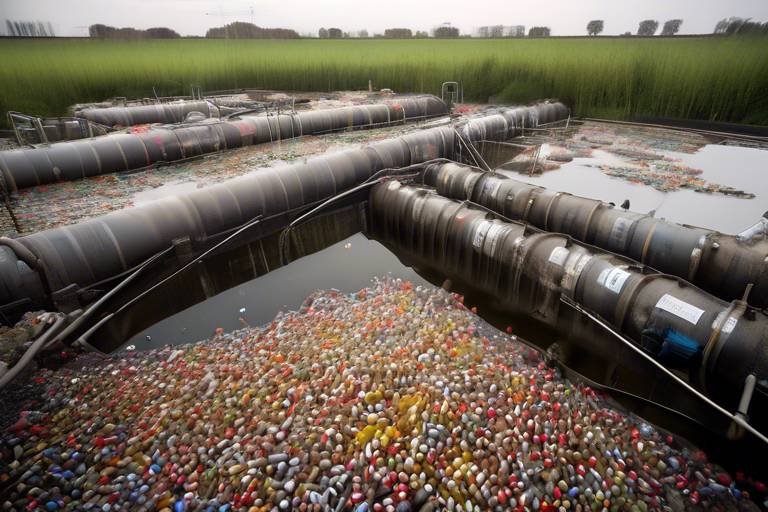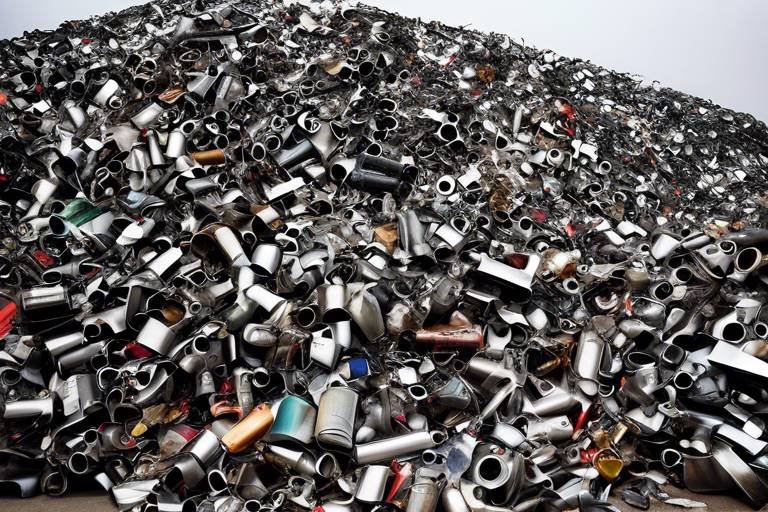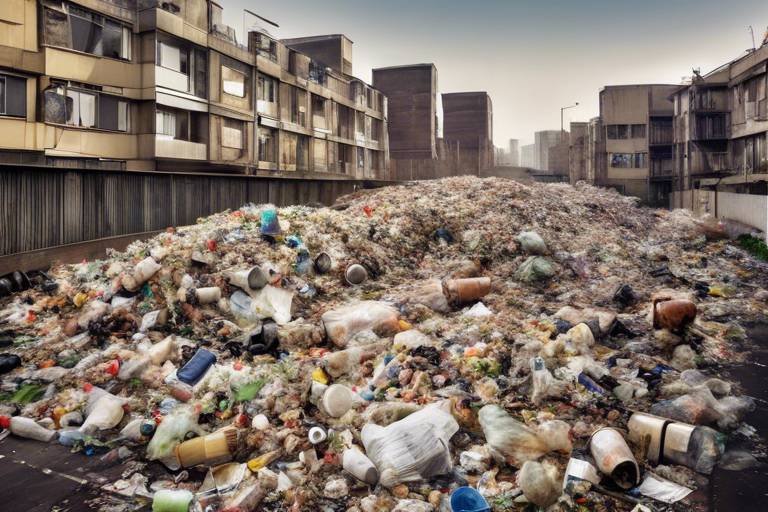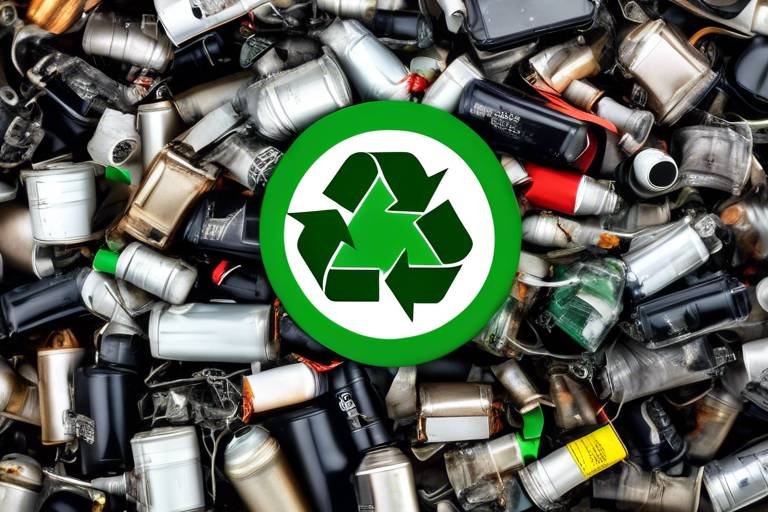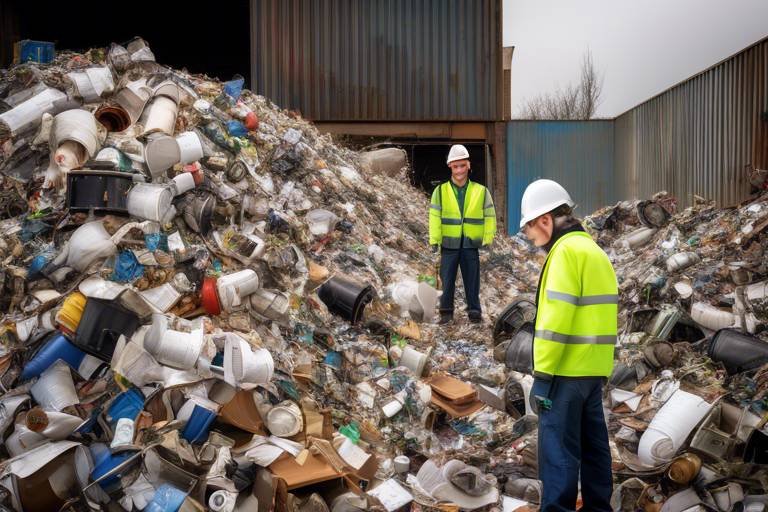The Role of Microbes in Waste Treatment
Microbes, those tiny organisms that we often overlook, play an absolutely crucial role in waste treatment processes. Imagine a world where our waste just piled up, creating an unsightly and hazardous environment. Fortunately, thanks to these microscopic heroes, we have a natural solution to tackle waste and pollutants. Microbial communities are the unsung champions of our ecosystems, breaking down harmful substances and converting them into less toxic forms. They not only help in waste management but also improve overall environmental health, making our planet a cleaner and safer place to live.
When we think about waste treatment, we often picture large treatment plants with complex machinery. However, the real magic happens at the microscopic level. Microbes interact with each other and their surroundings in a symbiotic dance, leading to enhanced degradation of organic matter and pollutants. This process is not just a simple task; it involves intricate relationships among various types of microbes that work together to achieve a common goal: cleaning up our mess.
In essence, microbes are nature's recyclers. They break down organic waste into simpler substances, allowing nutrients to be recycled back into the ecosystem. This not only reduces waste but also enriches the soil, promoting healthy plant growth. It's a beautiful cycle of life that underscores the importance of microbial activity in waste treatment. Without these tiny organisms, our landfills would overflow, and our water systems would become increasingly polluted.
As we delve deeper into the world of microbes in waste treatment, we discover a fascinating array of organisms, each with its own unique abilities and functions. From bacteria to fungi, these microbes employ various metabolic pathways to decompose waste materials effectively. So, the next time you think about waste management, remember that it's not just about machinery and chemicals; it's about the incredible power of microbes working tirelessly behind the scenes.

Understanding Microbial Communities
Microbial communities are fascinating ecosystems in their own right, often existing unnoticed in our environment. These communities consist of various microorganisms, including bacteria, fungi, and archaea, all interacting with each other and their surroundings in complex ways. Imagine a bustling city where every organism plays a specific role, contributing to the overall health and functionality of the community. This analogy holds true for microbial communities in waste treatment, where each microbe has a unique job that enhances the degradation of organic matter and pollutants.
One of the most intriguing aspects of these communities is their ability to adapt and thrive in diverse environmental conditions. They can be found in a variety of settings, from the depths of oceans to the soil beneath our feet, and even in the wastewater treatment plants that help cleanse our environment. The interactions among different types of microbes lead to a synergistic effect, where the collective action results in more efficient waste breakdown than any single organism could achieve alone. For instance, while some bacteria may excel at breaking down fats, others might specialize in digesting carbohydrates, creating a well-rounded team that can tackle a broad spectrum of organic waste.
Moreover, microbial communities are not static; they evolve over time in response to changes in their environment. Factors such as temperature, pH, and the availability of nutrients can influence the composition of these communities. For example, when organic waste enters a treatment facility, it alters the local conditions, prompting a shift in the microbial population as certain species flourish while others diminish. This dynamic nature is crucial for effective waste treatment, as it ensures that the microbial community can adapt to varying waste loads and compositions.
In waste treatment processes, understanding these communities is vital. By studying the interactions and functions of different microbes, scientists can optimize conditions to enhance microbial activity. This optimization can lead to improved efficiency in breaking down pollutants and reducing harmful substances in wastewater. In essence, recognizing the importance of microbial communities is like realizing that every player on a sports team contributes to the overall success of the game. Without these tiny players, the game of waste treatment would be far less effective.
In summary, microbial communities are essential players in waste treatment, working together in a symbiotic relationship to break down pollutants and enhance environmental health. Their adaptability and dynamic interactions make them a focal point for ongoing research and innovation in waste management practices. As we continue to explore these microscopic ecosystems, we uncover new ways to harness their power for a cleaner, healthier planet.

Types of Microbes in Waste Treatment
When it comes to waste treatment, the diversity of microbial life is nothing short of astonishing. Various types of microbes play distinct yet interconnected roles in breaking down waste materials. These tiny organisms are like the unsung heroes of our environment, tirelessly working to transform harmful substances into benign materials. Among them, we find bacteria, fungi, and archaea, each contributing unique metabolic pathways that facilitate the degradation of pollutants.
Bacteria are perhaps the most well-known players in this arena. They come in numerous varieties, each adapted to specific environmental conditions and types of waste. For instance, beneficial bacteria such as those from the genera Bacillus and Pseudomonas are essential for the decomposition of organic waste. They possess the remarkable ability to convert complex organic compounds into simpler, less harmful substances. This transformation is crucial in reducing the volume of waste and mitigating its impact on the environment.
But that's just the tip of the iceberg. Let's dive deeper into the fascinating world of microbes, shall we?
- Beneficial Bacteria: These microbes are the backbone of waste treatment processes. They break down organic materials and help in the detoxification of hazardous substances.
- Anaerobic Bacteria: Thriving in oxygen-deprived environments, these bacteria play a pivotal role in the fermentation process, breaking down organic matter and producing biogas as a byproduct.
- Aerobic Bacteria: In contrast, aerobic bacteria require oxygen to function. They are essential for oxidizing organic pollutants, making them vital in aerobic wastewater treatment processes.
Next up, we have fungi, which are equally important in waste treatment. These organisms excel at decomposing complex organic materials such as lignin and cellulose, which often resist bacterial degradation. Think of fungi as nature's recyclers; they break down tough plant materials that other microbes struggle with, making nutrients available for other organisms. Their role in composting and soil health cannot be overstated, as they contribute to the overall nutrient cycling in ecosystems.
Lastly, we can't overlook archaea, the lesser-known cousins of bacteria. While they may not be as prominent in waste treatment discussions, they play a critical role, especially in extreme environments. For example, methanogenic archaea are instrumental in anaerobic digestion processes, converting organic matter into methane, which can be captured and used as a renewable energy source. This process not only helps in waste reduction but also contributes to sustainable energy solutions.
In summary, the types of microbes involved in waste treatment are diverse and essential for maintaining environmental health. From bacteria to fungi and archaea, each group brings its unique strengths to the table, working together in a complex web of interactions that promote the degradation of pollutants and enhance nutrient recycling. Understanding these microbial communities is crucial for improving waste treatment technologies and ensuring a healthier planet.

Beneficial Bacteria
When we think about waste treatment, it’s easy to overlook the microscopic heroes working tirelessly behind the scenes. are the unsung champions of waste decomposition, playing a pivotal role in transforming organic waste into less harmful substances. These tiny organisms, particularly those in the genera Bacillus and Pseudomonas, are essential for breaking down complex organic materials. Imagine them as tiny recyclers, constantly munching away at waste and converting it into something that can be safely returned to the environment.
These bacteria possess unique metabolic pathways that allow them to digest a variety of waste products. For instance, Bacillus species are known for their ability to produce enzymes that break down fats, proteins, and carbohydrates, making them invaluable in the treatment of organic waste. Meanwhile, Pseudomonas species are particularly adept at degrading toxic compounds, including those found in industrial waste. The versatility of these bacteria is akin to having a Swiss Army knife in the world of waste management—equipped to handle multiple challenges!
But how exactly do these beneficial bacteria work their magic? Their processes can be summarized into a few key functions:
- Decomposition: They break down complex organic materials into simpler compounds.
- Nutrient Cycling: They facilitate the recycling of nutrients, making them available for plant uptake.
- Pathogen Suppression: By outcompeting harmful bacteria, they help maintain a balanced microbial environment.
Moreover, the presence of beneficial bacteria can significantly enhance the efficiency of waste treatment systems. In aerobic systems, for example, these bacteria thrive in oxygen-rich environments, where they accelerate the breakdown of organic matter. Conversely, in anaerobic systems, they adapt to low-oxygen conditions, showcasing their remarkable resilience and adaptability. This dual capability not only speeds up the treatment process but also reduces the overall environmental footprint of waste management practices.
In conclusion, the role of beneficial bacteria in waste treatment cannot be overstated. They are the backbone of microbial communities that ensure our waste is managed effectively and sustainably. By harnessing their power, we can improve waste treatment processes, promote environmental health, and ultimately create a cleaner, greener planet for future generations.

Role of Anaerobic Bacteria
Anaerobic bacteria are fascinating microorganisms that thrive in environments where oxygen is scarce or completely absent. This remarkable adaptability allows them to play a pivotal role in waste treatment processes, particularly in the breakdown of organic matter. Imagine a bustling underground city where these bacteria are the diligent workers turning waste into energy, all while helping to clean our environment. Their primary method of operation is through a process called fermentation, where they convert complex organic materials into simpler substances, releasing biogas as a byproduct. This biogas, primarily composed of methane and carbon dioxide, can be harnessed as a renewable energy source, making anaerobic bacteria not just waste decomposers but also valuable energy producers.
One of the most significant aspects of anaerobic bacteria is their ability to degrade a wide variety of organic compounds, including those that are resistant to breakdown by other microorganisms. For instance, they can effectively digest sewage sludge, agricultural waste, and even certain types of industrial waste. This capability is crucial for the efficiency of treatment plants, as it helps in significantly reducing the volume of waste that needs to be processed. In fact, anaerobic digestion can reduce the mass of solid waste by up to 90%, which is a staggering achievement when you consider the sheer volume of waste produced daily.
Moreover, the metabolic processes of anaerobic bacteria contribute to nutrient recycling. As they break down organic matter, they release essential nutrients such as nitrogen, phosphorus, and potassium back into the environment, which can then be utilized by plants. This natural cycle not only enhances soil fertility but also supports the growth of vegetation, creating a healthier ecosystem. It’s like having a team of tiny gardeners working tirelessly to enrich the earth while simultaneously cleaning up our mess.
To better understand the role of anaerobic bacteria in waste treatment, here’s a simple overview of their key functions:
| Function | Description |
|---|---|
| Organic Matter Decomposition | Breaks down complex organic materials into simpler compounds. |
| Biogas Production | Generates methane and carbon dioxide, which can be used as renewable energy. |
| Nutrient Recycling | Releases nutrients back into the environment, enhancing soil fertility. |
In conclusion, anaerobic bacteria are not just waste managers; they are essential players in the quest for sustainable waste treatment solutions. Their ability to thrive in low-oxygen conditions while efficiently breaking down waste materials makes them invaluable in our efforts to protect and preserve the environment. As we continue to explore innovative waste management techniques, understanding and harnessing the power of these microorganisms will undoubtedly lead us towards a cleaner, greener future.
- What are anaerobic bacteria? Anaerobic bacteria are microorganisms that do not require oxygen to live and thrive, often found in environments like swamps, deep soils, and landfills.
- How do anaerobic bacteria contribute to waste treatment? They break down organic materials through fermentation, producing biogas and helping to reduce the volume of waste significantly.
- What is biogas? Biogas is a renewable energy source produced during the anaerobic digestion of organic materials, primarily consisting of methane and carbon dioxide.
- Can anaerobic bacteria help in nutrient recycling? Yes, as they decompose waste, they release essential nutrients back into the soil, promoting plant growth and soil health.

Role of Aerobic Bacteria
Aerobic bacteria are like the superheroes of the waste treatment world. They thrive in environments rich in oxygen and play a pivotal role in the oxidation of organic pollutants. Imagine a bustling city where everyone is working together to clean up the streets; that's what aerobic bacteria do in wastewater treatment facilities. They break down complex organic compounds into simpler, less harmful substances, effectively transforming potentially hazardous waste into something much more manageable.
These bacteria are essential for processes such as activated sludge systems, where they form flocs—clusters of bacteria that settle out of the water and can be removed. This process not only cleans the water but also helps to recycle nutrients back into the ecosystem, promoting a healthier environment. The efficiency of aerobic bacteria is remarkable; they can reduce the biochemical oxygen demand (BOD) of wastewater significantly, which is a key indicator of water quality. In essence, they are nature's recyclers, ensuring that waste is not just disposed of but repurposed into something beneficial.
One of the fascinating aspects of aerobic bacteria is their metabolic diversity. Different species of aerobic bacteria have evolved unique pathways to utilize various substrates, which means they can break down a wide range of organic materials. Here are a few key functions they perform:
- Decomposition: They break down organic matter, such as food waste and sewage, into carbon dioxide and water.
- Nutrient Cycling: They help in the recycling of nutrients like nitrogen and phosphorus, which are essential for plant growth.
- Pollutant Removal: They can degrade toxic substances, including certain pharmaceuticals and industrial chemicals, making the water safer for discharge into the environment.
Moreover, the presence of aerobic bacteria can significantly improve the overall efficiency of wastewater treatment plants. By maintaining optimal oxygen levels in the treatment tanks, operators can ensure that these bacteria thrive and perform their essential functions effectively. Without them, the treatment process would be much less efficient, leading to higher levels of pollutants in the effluent and potentially harming aquatic ecosystems.
In summary, aerobic bacteria are indispensable players in the waste treatment process. Their ability to break down organic pollutants and recycle nutrients not only enhances the treatment efficiency but also contributes to a healthier environment. As we continue to face environmental challenges, understanding and harnessing the power of these microorganisms will be crucial for sustainable waste management practices.

Fungi in Waste Breakdown
When we think about the heroes of waste treatment, fungi often take a backseat to their bacterial counterparts. However, these remarkable organisms play an equally crucial role in breaking down complex organic materials that many bacteria simply can't handle. Imagine a bustling city where different neighborhoods specialize in various tasks—this is how microbial communities operate, with fungi acting as the skilled recyclers of the ecosystem.
Fungi are particularly adept at decomposing materials like lignin and cellulose, which are fundamental components of plant cell walls. These substances are tough cookies to crack, and without fungi, many of these organic materials would pile up, creating a significant burden on our environment. Fungi possess specialized enzymes that enable them to break down these complex compounds into simpler, more manageable forms. This process not only detoxifies the environment but also contributes to the nutrient cycling essential for healthy ecosystems.
One of the most fascinating aspects of fungi is their ability to form symbiotic relationships with plants through structures known as mycorrhizae. These relationships enhance nutrient uptake for plants while providing fungi with carbohydrates produced through photosynthesis. In the context of waste treatment, this partnership can be a game-changer. By improving soil structure and fertility, fungi help restore contaminated sites, making them more resilient and productive.
Moreover, fungi can thrive in a variety of environments, including those that are anaerobic (lacking oxygen) or highly polluted. This adaptability makes them invaluable in bioremediation efforts, where they can be employed to treat contaminated soils and waters. For instance, certain fungi are known to degrade hazardous compounds like polycyclic aromatic hydrocarbons (PAHs) and heavy metals, effectively detoxifying environments that have been compromised by industrial activities.
The integration of fungi into waste treatment processes often leads to enhanced efficiency and effectiveness. Here’s a quick overview of how fungi contribute to waste breakdown:
| Function | Impact on Waste Treatment |
|---|---|
| Decomposition of Complex Materials | Breaks down lignin and cellulose, reducing waste volume. |
| Nutrient Cycling | Releases nutrients back into the soil, promoting plant growth. |
| Bioremediation | Detoxifies hazardous substances, improving environmental health. |
In summary, fungi are not just passive participants in the waste treatment process; they are dynamic players that enhance the breakdown of complex organic materials, promote nutrient cycling, and facilitate bioremediation. Their unique metabolic capabilities and symbiotic relationships with plants make them indispensable allies in our quest for a cleaner, healthier planet. So, the next time you think about waste treatment, remember that fungi are working tirelessly behind the scenes, ensuring that our ecosystems remain vibrant and balanced.
- What types of fungi are used in waste treatment? Various types of fungi, including white rot fungi and brown rot fungi, are commonly used for their ability to break down complex organic materials.
- How do fungi contribute to bioremediation? Fungi can degrade hazardous substances and detoxify contaminated environments, making them effective agents in bioremediation efforts.
- Can fungi survive in polluted environments? Yes, many fungi have adapted to thrive in polluted environments, allowing them to play a crucial role in waste breakdown and environmental restoration.

Microbial Metabolism in Waste Treatment
Microbial metabolism is a fascinating and complex series of biochemical processes that play a pivotal role in waste treatment. Imagine a bustling city where tiny workers, the microbes, are constantly breaking down waste materials, transforming them into simpler, less harmful compounds. These microscopic heroes are essential for not only detoxifying hazardous waste but also for promoting nutrient recycling, which is crucial for maintaining a balanced ecosystem. The metabolic activities of these microbes can be broadly categorized into two main processes: catabolism and anabolism.
Catabolism refers to the breakdown of organic materials, where microbes convert complex substances into simpler molecules, releasing energy in the process. This energy is then used for various cellular functions, allowing the microbes to thrive and multiply. On the other hand, anabolism is the process where these microbes utilize the simpler molecules produced during catabolism to synthesize new cellular components, ensuring their growth and survival. Together, these processes form a continuous cycle that is vital for effective waste treatment.
One of the most significant aspects of microbial metabolism in waste treatment is biodegradation. This process involves the breakdown of organic substances through microbial activity, leading to the detoxification of hazardous waste. For instance, when organic pollutants are introduced into a wastewater treatment system, specific microbes are activated to metabolize these pollutants, converting them into harmless byproducts such as carbon dioxide, water, and biomass. This not only cleanses the wastewater but also reduces the environmental impact of these pollutants.
In addition to biodegradation, another crucial aspect of microbial metabolism is bioremediation. This technique harnesses the power of microbes to restore contaminated environments, such as polluted soil and water. By introducing specific microbial strains or enhancing the natural microbial populations present in the contaminated site, bioremediation can effectively treat a wide range of pollutants, including heavy metals, pesticides, and hydrocarbons. The beauty of this approach lies in its ability to utilize natural processes, making it an environmentally friendly solution to pollution.
To illustrate the effectiveness of microbial metabolism in waste treatment, consider the following table that summarizes the key metabolic processes and their impacts:
| Metabolic Process | Description | Impact on Waste Treatment |
|---|---|---|
| Catabolism | Breakdown of complex organic materials into simpler molecules. | Detoxifies hazardous waste, releasing energy for microbial growth. |
| Anabolism | Utilization of simpler molecules for synthesizing new cellular components. | Supports microbial growth and enhances degradation efficiency. |
| Biodegradation | Microbial breakdown of organic pollutants into harmless byproducts. | Reduces environmental impact and cleanses wastewater. |
| Bioremediation | Use of microbes to restore contaminated environments. | Effectively treats pollutants in soil and water. |
In conclusion, microbial metabolism is an integral part of waste treatment processes. Without these tiny but mighty organisms, our ability to manage waste effectively would be severely compromised. They not only help in detoxifying harmful substances but also play a vital role in recycling nutrients, thus contributing to a healthier environment. As we continue to face the challenges of pollution and waste management, understanding and harnessing the power of microbial metabolism will be essential in developing sustainable solutions.
- What are microbes? Microbes are tiny living organisms, including bacteria, fungi, and archaea, that are often invisible to the naked eye but play significant roles in various environmental processes.
- How do microbes help in waste treatment? Microbes break down complex waste materials into simpler, less harmful compounds through metabolic processes, thus detoxifying hazardous substances and promoting nutrient recycling.
- What is biodegradation? Biodegradation is the process by which microbes decompose organic substances, leading to the detoxification of hazardous waste and the production of harmless end products.
- What is bioremediation? Bioremediation is a technique that utilizes microbes to restore contaminated environments, effectively treating pollutants in soil and water through natural or engineered microbial processes.

Biodegradation Processes
Biodegradation processes are nature's way of recycling organic materials, and they play a vital role in waste treatment. Imagine the earth as a giant compost bin, where all the organic waste we produce is broken down into simpler, less harmful substances by tiny living organisms. These processes not only detoxify hazardous wastes but also convert them into substances that can nourish the environment. Microbes, particularly bacteria and fungi, are the key players in this incredible transformation.
When we talk about biodegradation, we refer to a series of biochemical reactions that are initiated by microbes. These reactions can be categorized into two main types: primary biodegradation and secondary biodegradation. In primary biodegradation, microbes attack the complex structures of organic compounds, breaking them down into simpler molecules. This stage is crucial because it reduces the toxicity of the waste material. For instance, petroleum hydrocarbons, which are notoriously difficult to degrade, can be broken down by specific strains of bacteria into simpler, less harmful compounds.
Once the primary biodegradation has occurred, the simpler compounds can undergo secondary biodegradation, where they are further broken down into even simpler substances, such as carbon dioxide, water, and biomass. This is where the magic happens! The end products of these processes are not only less harmful but can also be utilized by other organisms, thus promoting nutrient cycling in ecosystems.
One fascinating aspect of biodegradation is that it can occur under different environmental conditions. For instance, in anaerobic conditions—where oxygen is absent—certain bacteria thrive and decompose organic matter through fermentation. This process produces biogas, which can be harnessed as a renewable energy source. Conversely, in aerobic conditions, where oxygen is plentiful, aerobic bacteria oxidize organic pollutants, effectively breaking them down into harmless substances. This dual capability of microbes to adapt to varying conditions showcases their resilience and importance in waste treatment.
To illustrate the significance of biodegradation, consider the following table that summarizes the key differences between aerobic and anaerobic biodegradation:
| Feature | Aerobic Biodegradation | Anaerobic Biodegradation |
|---|---|---|
| Oxygen Requirement | Requires oxygen | Occurs in the absence of oxygen |
| End Products | Carbon dioxide and water | Biogas (methane) and organic acids |
| Microbial Activity | Faster degradation rates | Slower degradation rates |
| Common Microbes | Aerobic bacteria (e.g., Pseudomonas) | Anaerobic bacteria (e.g., Methanogens) |
In summary, biodegradation processes are essential for the detoxification of hazardous waste and the conversion of organic materials into harmless end products. By harnessing the power of microbes, we can effectively manage waste and contribute to a healthier environment. It’s like having a team of tiny superheroes working tirelessly to clean up our mess, ensuring that our planet remains a sustainable place for future generations.

Bioremediation Techniques
Bioremediation techniques are fascinating methods that harness the power of microbes to restore contaminated environments. Imagine nature's very own cleanup crew, working tirelessly to break down pollutants and detoxify hazardous waste. These techniques can be categorized into two main approaches: natural bioremediation and engineered bioremediation.
In natural bioremediation, microbes present in the environment already start breaking down contaminants without any human intervention. This process can take time, but it is often more sustainable and less intrusive. For instance, in oil spills, certain bacteria can naturally degrade the hydrocarbons present in crude oil, helping restore the ecosystem over time. On the other hand, engineered bioremediation involves the deliberate introduction of specific microbial strains into contaminated sites to enhance the degradation process. This method can be tailored to target particular pollutants, making it a powerful tool in environmental cleanup.
One of the most common engineered bioremediation techniques is bioaugmentation, where beneficial microbes are added to a contaminated site to improve the degradation of pollutants. These microbes can be specially selected for their ability to metabolize specific compounds, such as heavy metals or organic solvents. Another approach is biostimulation, which involves modifying the environment to stimulate the growth of indigenous microbes. This can be achieved by adding nutrients or oxygen to promote microbial activity, leading to faster degradation of contaminants.
To illustrate the effectiveness of bioremediation techniques, consider the following table that summarizes different methods and their applications:
| Bioremediation Technique | Description | Applications |
|---|---|---|
| Natural Bioremediation | Utilizes existing microbial populations to degrade pollutants. | Oil spills, landfill leachate |
| Bioaugmentation | Introduces specific microbes to enhance degradation. | Heavy metal contamination, pesticide breakdown |
| Biostimulation | Enhances microbial activity by adding nutrients or oxygen. | Contaminated groundwater, soil remediation |
Moreover, bioremediation techniques are not just limited to soil and water; they can also play a significant role in treating industrial waste. Industries often generate waste that contains harmful chemicals, and using microbes to treat this waste can lead to safer disposal methods. This not only helps in reducing the environmental footprint of these industries but also promotes a circular economy by recycling valuable materials.
In conclusion, bioremediation techniques represent a cutting-edge approach to tackling pollution. By leveraging the natural abilities of microbes, we can effectively address environmental challenges while promoting sustainability. It’s a win-win situation for both humanity and the planet!
- What is bioremediation? Bioremediation is the process of using microbes to break down and remove pollutants from the environment.
- How long does bioremediation take? The duration can vary significantly based on factors like the type of contaminant and environmental conditions, ranging from weeks to several years.
- Is bioremediation safe? Yes, bioremediation is generally considered safe as it uses natural processes and organisms to clean up pollutants.
- Can bioremediation be used for all types of contaminants? While bioremediation is effective for many organic pollutants, it may not be suitable for all contaminants, especially some heavy metals and radioactive materials.
Frequently Asked Questions
- What are microbes, and why are they important in waste treatment?
Microbes are tiny living organisms, including bacteria, fungi, and archaea, that play a crucial role in breaking down waste materials. They are essential because they help decompose organic matter, convert pollutants into less harmful substances, and improve environmental health. Without these tiny powerhouses, waste treatment would be much less effective!
- How do different types of microbes contribute to waste treatment?
Different microbes have unique abilities that make them invaluable in waste treatment. For instance, beneficial bacteria, like those from the genera Bacillus and Pseudomonas, excel at decomposing organic waste. Anaerobic bacteria thrive without oxygen, breaking down matter through fermentation, while aerobic bacteria need oxygen to oxidize organic pollutants. Each type plays a specific role in ensuring effective waste management.
- What is biodegradation, and how does it work?
Biodegradation is the process where microbes break down organic substances into simpler, harmless compounds. Think of it as nature's recycling system! This process detoxifies hazardous waste, making it safe for the environment. The end products are often non-toxic and can be further utilized by plants or other organisms, promoting nutrient recycling.
- Can you explain bioremediation techniques?
Absolutely! Bioremediation techniques harness the power of microbes to clean up contaminated environments, such as polluted soil and water. This can be done naturally or through engineered processes that enhance microbial activity. By using these techniques, we can effectively treat pollutants, making our ecosystems healthier and more resilient.
- Are there any specific fungi involved in waste breakdown?
Yes, fungi are key players in waste treatment! They specialize in decomposing complex organic materials, such as lignin and cellulose, which are often resistant to bacterial degradation. By breaking down these tough substances, fungi help in the overall waste treatment process, ensuring that even the most challenging materials are processed efficiently.
- How do microbes improve environmental health?
Microbes enhance environmental health by breaking down pollutants and organic waste, thus reducing contamination in soil and water. This not only detoxifies hazardous substances but also promotes nutrient cycling, which is vital for maintaining healthy ecosystems. In essence, they are like nature's clean-up crew, working tirelessly to restore balance!

